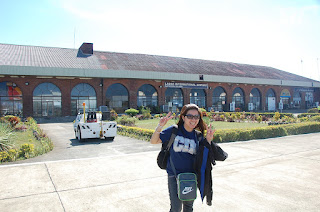Ilocos Region
Based on our flight schedule, we had to leave Cebu on February 22nd at around 6:30 in the morning aboard a Cebu Pacific flight to Manila. In Manila, we had to board another flight, this time a Philippine Airlines flight, to Laoag City. Both flights were smooth and stress-free owing to the fair weather condition.
It was in Laoag where we had to start the actual sight-seeing. Lucky for us , we found a tricycle driver who offered to tour us around Laoag and Vigan using his friend's van, which we had to rent for Php 3,000.00 (that is P1,000.00 for each of us).
TRANSPORT NEGOTIATION
 | ||
Notice the cab! It's much of an inconvenience. I could not last an hour inside that cab.
|
First Stop: Museo Ilocos Norte
The Museum showcases a vast collection of historical and cultural artifacts representing not just the Ilocano but the Filipno nation in general. Old hispanic era furnitures and vessels, lamps, traditional dresses are only a few examples of the museums collections. It also features some of Juan Luna's painting.
The edifice was formerly known as the Tabacalera. It was designed as the administrative center of the Ilocos' Tobacco monopoly during the Spanish Occupation. According to its official website, the museum "symbolizes the wealth of Ilocos Norte, with its 'varied ethnicity' and 'multi-faceted cultural heritage'--something that holds true to the rest of the Filipino nation.
I created a video presentation of out of the pictures taken inside the museum. Please take time to view. (N.B. The background music is "Lahing Kayumanggi, by Mr. Willy Buena, Bread of Life Ministries International; No Copyright Infringement intended)
There are some interesting pictures that deserve special mention. One of them is the photo taken of a painting showing a French lady and three gentlemen watching her. Our tour guide pointed to us that the lady is actually a representation of the Philippine Islands. Notice the profile of the lady in the following photo.
The lady does form like the map of the Philippines on the flip side. This is in fact just a replica of a famous Luna painting "The Parisian Life". The original painting was procured by the GSIS museum from Christies in an auction in Hongkong, way back in 2002. Now the famous painting is housed at the University of Santo Thomas' Museum of Arts and Sciences.
LAOAG SAND DUNES
The sand dunes of Laoag can be found a few kilometers outside of the city. The place was just so amazing that words are not enough to describe the place. Just take a look at the following.
MALACANANG OF THE NORTH
Called Malacanang ti Amianan in Ilocano, Malacanang of the North now houses the memorabilia of the former strongman Ferdinand Marcos. Magnificent chandeliers, furnitures, a piano and a collection of rare paintings depicting the Marcos family can be found inside. There are also a collection of life-sized wax statues of the former president.
A BEAUTIFUL COLLECTION OF SPANISH ERA ARCHITECTURE
The Philippines is a show-window of Spanish architecture. The whole archipelago is dotted with ornate churches, imposing bell towers and buildings. In the Philippines, it is not uncommon to see a church and a town hall, both spanish inspired, facing each other with only the town plaza separating them. Ilocos Regions is no exception.
Tobacco Monopoly Tower
A few meters away from the Museo Ilocos Norte is where the Tobacco Monoply Tower. The tower was erected in honor of the Spanish King Alfonso XIII for putting an end to the oppressive Tobacco Monopoly.
Sinking Bell Tower of Laoag
This is the Sinking Bell Tower of Laoag. It's amazing how a centuries-old structure and a modern convenience (Western Union) stand side by side.
Paoay Church and Belfry
 |
The Church of San Agustine in Paoay is a UNESCO World Heritage Site. It's facade exhibits a fine example of baroque style architecture. There are only four such types of church architecture in the Philippines and all of them are UNESCO World Heritage Sites.
The location of the Philippines in the Pacific Ring of Fire necessitated the construction of huge foundations and buttresses. This huge foundations and buttresses are reminiscent of the oriental style in architecture. Notice the following pictures. Sure they do remind me of an Asian temple like Burobudor or Angkor Wat.
Bantay Church and Tower, Bantay, Ilocos Sur
Shrine of Our Lady of the Charity, Patroness of Nueva Segovia
Surely one would not miss this beautiful landmark when visiting Vigan from Laoag. Bantay is a neighboring town of Vigan City. Church and tower is fronting the Vigan City welcome gateway.
Does the tower look familiar? If you happen to see the movie Panday, top-billed by the former Fernando Poe, Jr,, surely you would realized that the town, specially the belfry and church, is one of its shooting locations. On one of the bells on top of the tower, that was where the FPJ pulled the Panday sword as as you would see on the movie
(collaged)

VIGAN'S CALLE CRISOLOGO
Capping our Ilocos junket was a dinner at Vigan's renowned Calle Crisologo. This is a well-preserved (preserved enough that it is one of UNESCO's World Heritage Sites) Spanish-era street right in the heart of Vigan City.
Note that this is just the first part of the trip and more will be coming. So, watch out.



























Comments